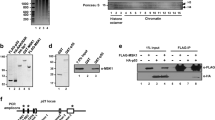Abstract
The ability of p53 to function as a tumor suppressor is linked to its function as a transcriptional activator, since p53 mutants that do not transactivate are unable to suppress tumor cell growth. Previous studies identified an activation domain in the amino terminal 40 residues of the protein, a region that binds to several general transcription factors and to some oncogene products. For example, mdm-2, a cellular oncoprotein, binds to this region and represses p53 transactivation. Here we describe a new activation domain within the amino terminus of p53 that maps between amino acids 40 – 83, and whose residues trp-53 and phe-54 are critical for function both in yeast and in mammalian cells. In vivo studies in yeast show that the new activation subdomain, unlike the previously described, is mdm-2 independent. Both p53 activation subdomains (1 – 40 and 40 – 83) require the yeast adaptor complex ADA2/ADA3/GCN5 for transcriptional activation. Moreover, since activation by p53 requires GCN5's enzymatic histone acetyltransferase domain, p53 may regulate gene expression by influencing chromatin modification.
Similar content being viewed by others
Author information
Authors and Affiliations
Rights and permissions
About this article
Cite this article
Candau, R., Scolnick, D., Darpino, P. et al. Two tandem and independent sub-activation domains in the amino terminus of p53 require the adaptor complex for activity. Oncogene 15, 807–816 (1997). https://doi.org/10.1038/sj.onc.1201244
Received:
Revised:
Accepted:
Issue Date:
DOI: https://doi.org/10.1038/sj.onc.1201244
- Springer Nature Limited
Keywords
This article is cited by
-
Structural diversity of p63 and p73 isoforms
Cell Death & Differentiation (2022)
-
The multiple mechanisms that regulate p53 activity and cell fate
Nature Reviews Molecular Cell Biology (2019)
-
Deconstructing networks of p53-mediated tumor suppression in vivo
Cell Death & Differentiation (2018)
-
Mechanisms of transcriptional regulation by p53
Cell Death & Differentiation (2018)
-
Therapeutic targeting of p53: all mutants are equal, but some mutants are more equal than others
Nature Reviews Clinical Oncology (2018)




